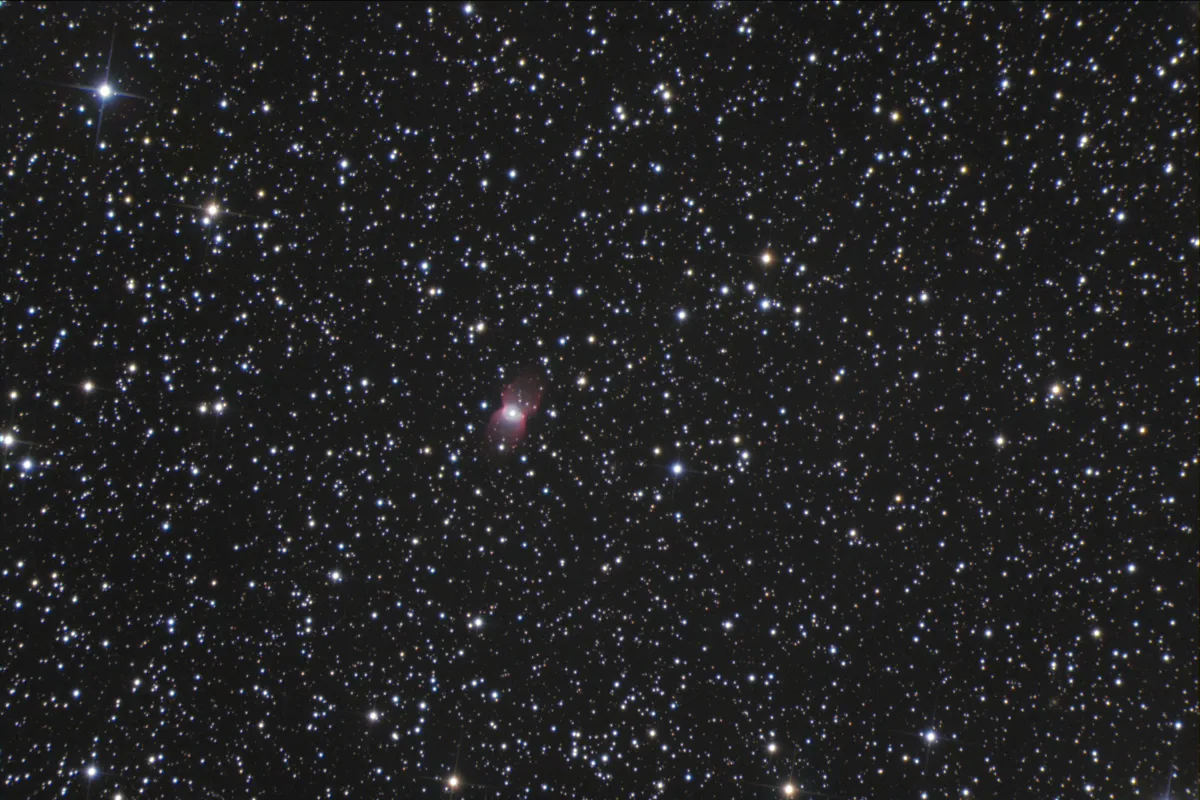Butterfly Nebula (NGC 2346)

Object Description
The nebula was discovered by William Herschel on 5 March 1790 using his 18.7 inch reflector with 20 feet focal length. He cataloged the nebula as IV 65 and described it with: «A pretty considerable star, 9 or 10m. visibly affected with very faint nebulosity, of very little extent all around. A power of 300 shewed the same, but gave a little more extent to the nebulosity. The 22d Monocerotis was quite free from nebulosity.» [465] Later the nebula was adopted by his son John as GC 1500 and in 1888 by Dreyer as NGC 2346. [313]
NGC 2346 is an unusual planetary nebula (PN), this is already evident from its outward appearance. The object is aptly described in the usual classification scheme by Vorontsov-Velyaminov: an irregular disk with traces of a ring structure, but overall an abnormal shape (IIIb+VI). The nebula's butterfly-like outline suggests that a dense ring of dust resides around the central star. This assumption was confirmed by infrared observations. The equatorial dust ring prevents the stellar wind emanating from the central star from escaping unhindered in all directions. The wind collides with the dust ring and heats it up. At the poles, however, he comes through practically unhindered. This involves collisions with matter ejected in earlier stages of the star, resulting in the formation of shock fronts. This effect is also called the snowplow effect, since the stellar wind penetrates the surrounding gas like a snow plow. This leads to the formation of two huge balloon-like structures that emanate from the poles of the dust ring. One speaks of a bipolar structure.

The difference between bipolar PNs and «real» bipolar nebulae is that PNs are always emission nebulae, i. e. self-luminous nebulae, and «real» bipolar nebulae are reflection nebulae such as Hubble's Variable Nebula (NGC 2261). Long exposure images from the European Southern Observatory (ESO) show a maximum extension of the nebula of 140 arc seconds, which corresponds to a diameter of 1.6 light years at a distance of 2300 light years.
A special feature is the central star V651 Monocerotis (or rather the central stars) of NGC 2346. The spectral lines show blue and red shifts with a period of 15.991 days, which suggests a binary star system. The main component is a blue main sequence star (spectral class A), while its companion is a very hot O subdwarf. The latter largely contributes to the ionization of the planetary nebula. Its surface temperature measures 100'000 Kelvin. The special feature lies above all in the variability of the star. In 1981 Kohoutek noticed a drastic decrease in brightness. Later, there were further irregular and varying degrees of brightness decreases.

As has been confirmed by infrared observations, dark dust clouds pass in front of the central star from time to time, noticeably weakening its light. The 11.16 vmag bright star can thus be dimmed by several magnitudes, as was the case in the winter of 1982. However, such phases of «cloud eclipses» are rare. Photographs taken between 1899 and 1981 show no sign of an eclipse. Luckily, since 1981 we are in a new eclipse phase! Since one does not know how long such phases last and how often they are to be expected, the object should be given the greatest possible attention. The darkening occurs in UV light usually occur 8 days before and after the visual event. Brightness measurements and estimates of the central star of NGC 2346, whether by amateur or professional astronomers, are of great scientific value and urgently needed today and tomorrow. From this, important conclusions can be drawn about the dust clouds orbiting the star and any planetesimals that may be present.
| Designations | PN G215.6+03.6: NGC 2346, PK 215+03.1, ARO 80, M 1-10, Sa 2- 5, VV 33, VV' 54 |
| Right Ascension (J2000.0) | 07h 09m 24s |
| Declination (J2000.0) | +00° 38' 31" |
| Dimensions | 52." (optical) |
| Distance | 0.64 kpc |
| Radial Velocity | +20.0 ± 3.0 km/s |
| Expansion Velocity | 8.0 (O-III) 12.5 (N-II) km/s |
| C-Star Designations | AG -00 965, AG82 74, CSI -00 -7068 0, HD 293373, V651 Mon |
| C-Star Magnitude | B: 11.78, V: 11.47 |
| C-Star Spectral Type | ? + A2 V |
| Discoverer | MINKOWSKI 1946 |
How to find the Butterfly?
The Butterfly Nebula lies between the bright stars Sirius (α Canis Majoris) and Procyon (α Canis Minoris) near the 4.2 mag star δ Monocerotis. The PN is found just 40 arc minutes west-south-west of δ Monocerotis. It can already be seen in a 15cm telescope as a faint, rectangular nebula.
Visual Observation

200 mm aperture: In the 8-inch SCT, the butterfly appeared as a diffuse, slightly oval nebula with medium to good visibility. Even at magnifications over 300x, I could not see a clearly defined shape. The nebula appeared with no internal structure even when using an OIII filter. The brightness decreases towards the outside. The variable central star was clearly visible at the time of observation (01/04/1997).

400 mm aperture: The bright central star catches the eye first. It is easily visible within the nebula disc, which is not the case with every planetary nebula. The nebula appears very weakly elongated and shows a hard transition to the sky background in two areas, similar to M 27, for example. The axis of elongation is indicated by the lines in the sketch. Structures are indicated on the disk; the brightness distribution is uneven.
